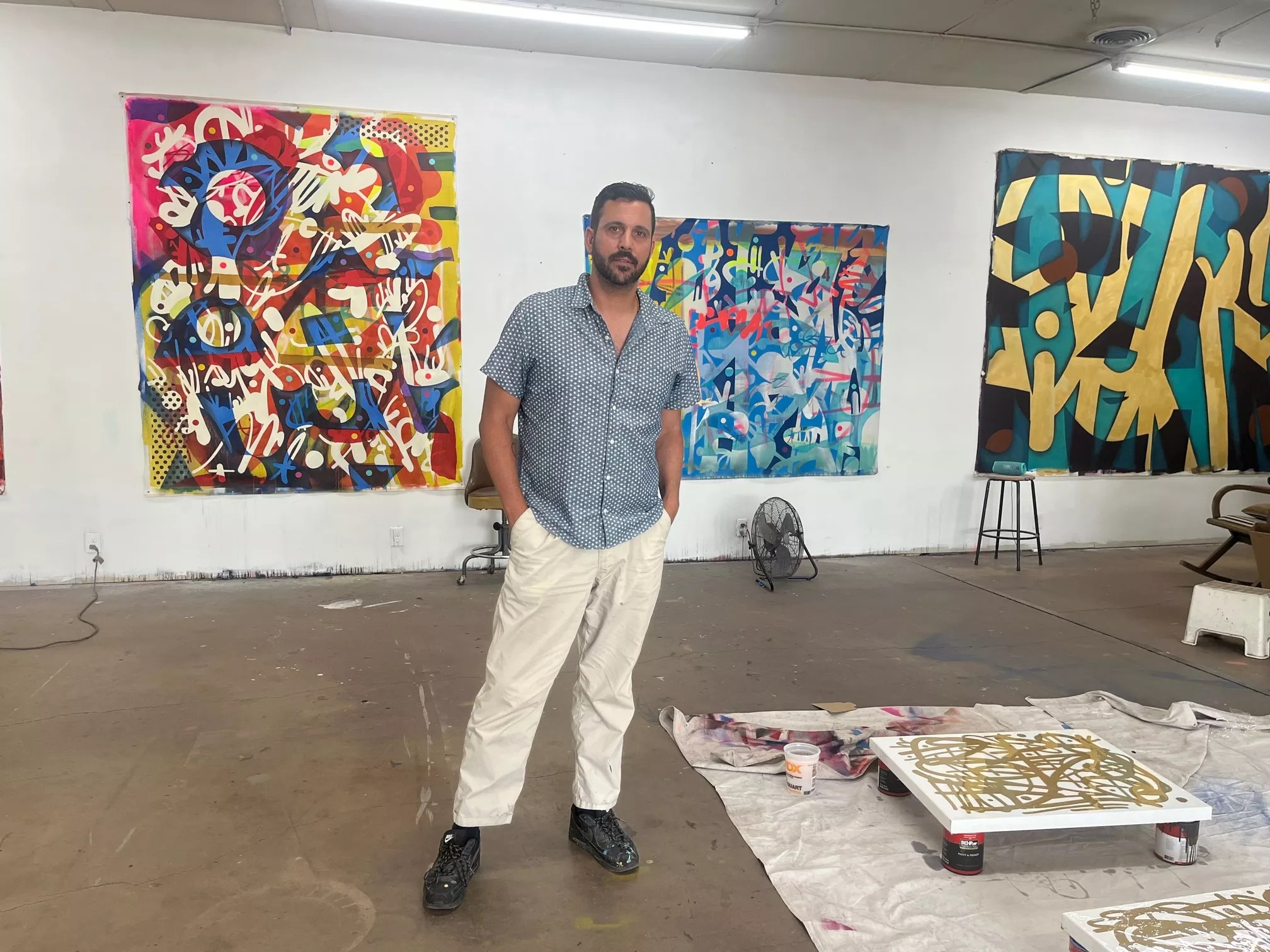
Ryann Gordon

Audio By Carbonatix
After moving from Brooklyn to North Texas 11 years ago, JM Rizzi became one of Dallas’ more notable artists, with publicly and privately funded murals and sculptures across the globe.
Rizzi’s murals decorate massive walls across DFW, from Trinity Groves to University Trail, Mockingbird Station, Sylvan Pass and the Toyota headquarters. They also span the nation, from his home state of New York to California, Florida and Chicago, to name a few. His artwork can be found much farther away too; he’s done murals and large-scale sculpture installations in China, Saudi Arabia, Denmark, Sweden and other countries.
But Rizzi’s humble disposition hasn’t been tainted – though his paint-tattered shoes may be. Kicked back in baggy jeans and a plain, oversized T-shirt, he still carries the style and swag of a New Yorker, his accent remaining marked by a cool cadence and a vernacular true to a Northeasterner.
“There were not many artists in my life as a kid,” says Rizzi, “but there was a comic book store that opened up in my neighborhood. So many people who worked in there were aspiring comic artists, so I got to see them drawing. I used to copy a lot of comic books. That was what brought some attention to me. I was the artist in my family, in my school, in my neighborhood. It kind of became a thing I did.”
Dallas, make your New Year’s Resolution Count!
We’re $11,750 away from our End-of-Year campaign goal, with just a few days left! We’re ready to deliver — but we need the resources to do it right. If Dallas Observer matters to you, please contribute today to help us expand our current events coverage when it’s needed most.
Rizzi’s family moved homes quite a bit, but art was one constant in his life, he says.
“We moved a few times when I was young at a few pivotal points, so making art became a big thing,” he says. “I was a skater, and in Staten Island where we moved, at that point there were no skaters out there, and I was into art, and I was into music. Those were the three things I had: art, music and skateboarding. I could control those things.”
There are elements in his work that trace back to his upbringing in New York, where graffiti and tagging are prominent. Recognizable by sweeping, intersecting lines with defined borders, his style is inspired by what he calls “asemic writing,” a type of writing with no actual meaning.
“It definitely has roots in writing,” he says. “My work is probably more asemic, and it’s a type of writing that has no semantic value. Then mix that in with the graffiti movement and tagging, and ink, and taking that style, and instead of writing a word, creating abstract compositions.”
Referencing artists Cy Twombly and Franz Kline as inspirations, Rizzi recalls one of the moments that shaped him while studying art and graphic design at the School of Visual Arts in Manhattan.
“I saw these things, these Kline drawings in an art history class from like the 40s, and I thought, oh shit, if that’s art then what I’m thinking fits,” he says. “OK, that’s considered art, then it’s like, game on.”
His highly distinctive style often represents swirling lines imitating cursive letters that cover large tapestries and smaller canvases, even massive sculptures that, though three-dimensional, are still immediately recognizable as his work.
“There’s always letters in there,” he says. “Those letters can change over time and they sort of come out organically. I tend to have a lot of circles in there, and I’ll use these dots as anchor points in the artwork. It helps to kind of anchor the movement I’m trying to convey in the paintings. It’s interesting, when I take those out, the piece has a different feel. It’s almost like the dots move your eye around the composition.”
The artist say that his method almost always starts with drawings. Whether it’s a large canvas or smaller sketchbook, he starts with his asemic writings, copies and digitizes them, then magnifies deep within to find the areas he wants to expand in a larger medium.
“My go-to is just black ink on paper or canvas,” he says. “And from there I kind of find compositions, and then I experiment with all sorts of different materials, from spray paint to acrylic, to oil paint, to collage. The drawings act as the seeds to ideas. Then I get really experimental.”
Non-representational in nature, Rizzi’s works are abstract expressionism above all else. His art contains scaling lines, abstract shapes and sharp boundaries with vivid color interactions, making them highly sought after when it comes to decorative murals.
“So many muralists nowadays are super representational,” he says. “I did this mural festival in Sacramento and everybody was doing these hyper-realist designs, you know animals with feathers, really detailed. And that’s not my lane. So I went the opposite and just went ‘boom.’ It allows people to create their own experience. As opposed to me saying, this is what it is, this is what you should see and be aware of.”
While street art also serves as a means of expression for justice or social reform, Rizzi is content with art that stands on its own merit.
“There’s no political narratives,” he says. “I don’t try to do that, I just try to express human expression. It’s just art for the form of human expression. I live in this time period and this is what I did in that time period. There’s connections to different lineages and different art movements. I’m just adding my voice to the conversation that is art.”